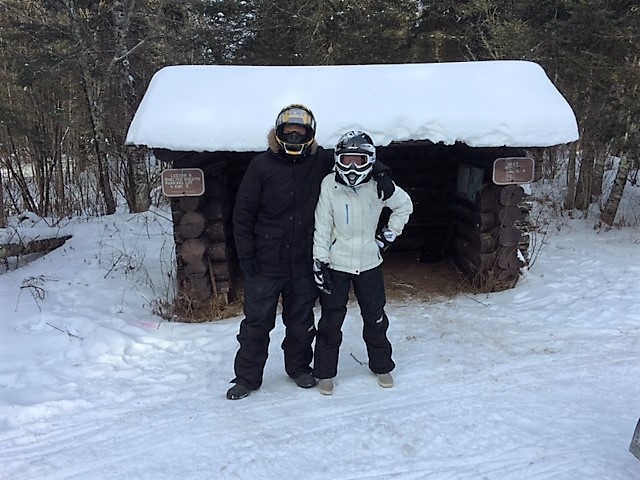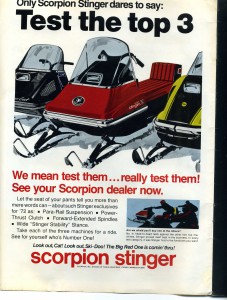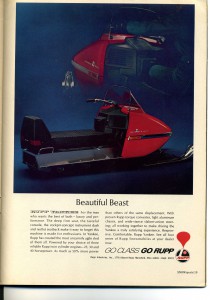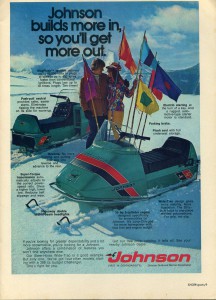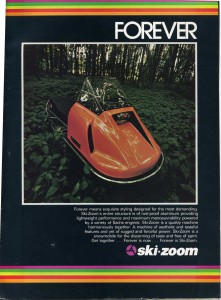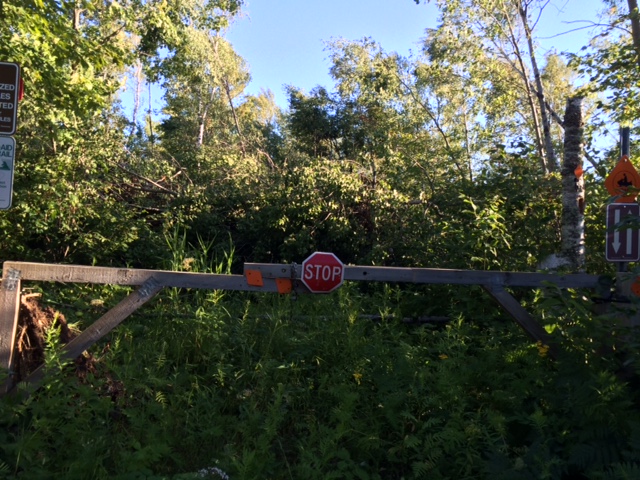We had a fantastic ride today and bumped into the Thedens from Hermantown at the shelter on the beautifully groomed Reservoir Lakes Trail, part of the Reservoir Riders trail system Near Island and Fish Lakes north of Duluth. Our apologies to the Thedens for Allen creeping into the shot…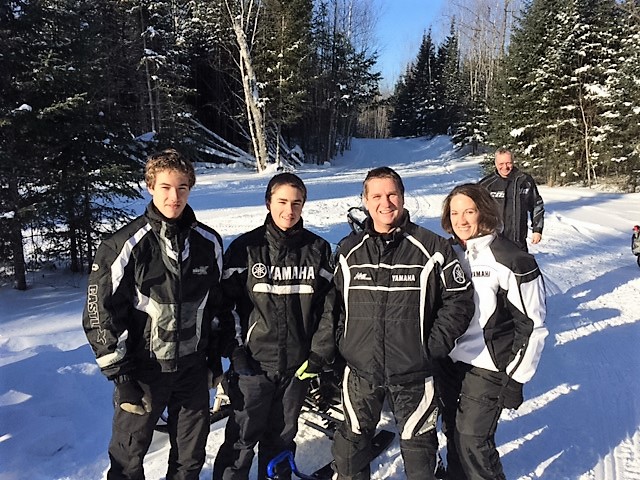
Author Archives: John Hartley
TODAY ON THE TRAIL: 1/8/17
BOMBARDIER’S SNOPLAN ENSURED SNOWMBILING’S FUTURE
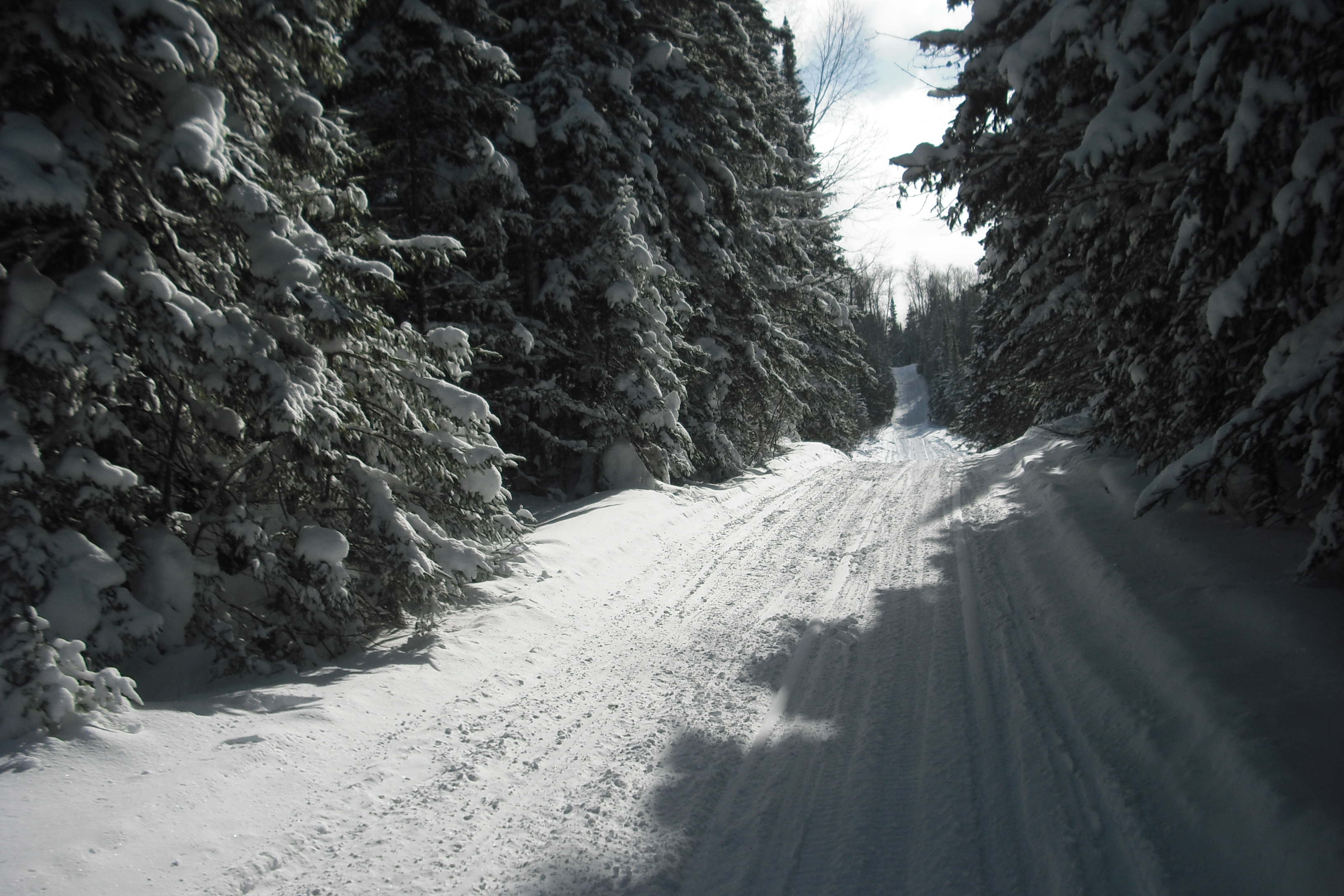
Picturesque scenes like this were made possible by the work done by visionaries of snowmobiling’s early days
As we not so patiently wait for snow here at snowmobiletrail.com headquarters we’ve decided that this November’s focus would be on trails, because without trails to ride our sport could not survive. Today all throughout Canada and the U.S. we enjoy a vast well marked and well maintained trail system, but things weren’t always this way.
In the early days of snowmobiling, riding was restricted to lakes, power lines, old hiking trails, abandoned logging roads and trails that people had cut through the woods to access their cabins. The manufacturers knew that a well organized trail system would be needed to ensure the continuation of the sport. Like many of his contemporaries, Ski-Doo’s Laurent Beaudoin, Joseph Armand Bombardier’s son-in-law, saw this need and tackled it head on. The result of his effort was called SnoPlan. SnoPlan was a program designed to find and catalog great snowmobiling destinations in the U.S. and Canada and then create a comprehensive trail network to link these destinations. Although his vision was shared by other manufacturers in the US and Canada it was Beaudoin who spearheaded the effort to include the provincial government of Quebec in his plan, convincing them that an organized and regulated trail network throughout Quebec would be beneficial to the economy and his theory proved to be correct as Quebec saw a massive spike in winter tourism dollars. It wasn’t long before other states and provinces followed suit, creating a vast network of trails with the help of local snowmobile clubs. It is because of visionaries like Laurent Beaudoin and vast numbers of snowmobile club members from the late sixties and early seventies that we enjoy the incredible trail system that we have today, and the trail work is continued by modern clubs with the assistance of private landowners creating an ever growing trail network making it easier to reach new destinations. Throughout the winter we will be detailing some of these destinations in Northeast Minnesota with our DESTINATION articles and highlighting several trails of interest in our TRAIL IN FOCUS segments. Don’t forget to watch for us out on the trails this winter and you might find yourselves on the website and Facebook page in our TODAY ON THE TRAIL photos! We only have a couple of weeks left until the official open of snowmobile season December 1st- until then think snow!
HOW TO FIND A PERFECTLY GROOMED TRAIL
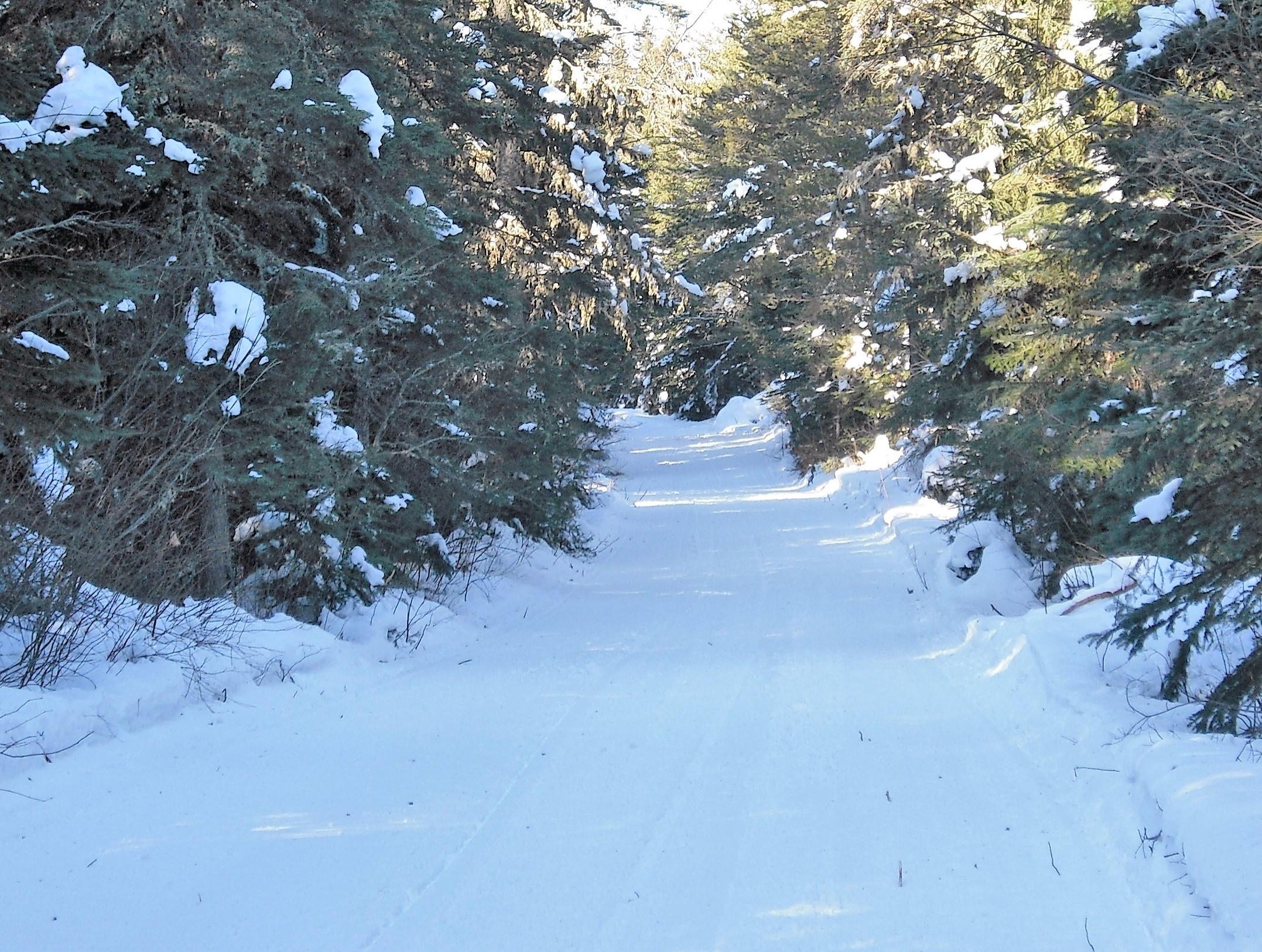 Its early morning. You unload your sled from the trailer and head out of the parking lot. You turn onto the trail and there it is- an untouched perfectly flat pan of freshly groomed trail without a track anywhere to be seen. You glance over at your buddy and you can tell he is grinning from ear to ear under his helmet. It’s going to be a perfect day.
Its early morning. You unload your sled from the trailer and head out of the parking lot. You turn onto the trail and there it is- an untouched perfectly flat pan of freshly groomed trail without a track anywhere to be seen. You glance over at your buddy and you can tell he is grinning from ear to ear under his helmet. It’s going to be a perfect day.
If you have ridden a snowmobile for any period of time then this scenario has happened to you at least once and if you are lucky it has happened several times, but how can you make this scenario occur more often? Believe it or not there are several things you can do to ensure yourself of better riding conditions more often, the problem is that there are far too many people that don’t do these things and it makes riding worse for everyone.
There is nothing quite like being the first sled to lay down a track on a freshly groomed trail. But that trail doesn’t get that way by accident or dumb luck. Unfortunately there are still a lot of snowmobilers out there that don’t quite know what goes into getting their local trail groomed on a regular basis. There is an underlying assumption that your states DNR is responsible for the state trails and that they handle grooming and maintenance of those trails, but, for the most part, very little of that is true. In Minnesota for example 90% of all of the trails in the Minnesota trail system are Grant-in-Aid trails, which means that those trails are built, maintained and groomed by local snowmobile clubs with the cooperation of the land owners that the trail runs on. That means only 10% of the trails in Minnesota are actually maintained by the DNR, but even in those cases local clubs are still charged with the grooming duties for the state run trails. So how do the local clubs get money to build these trails and maintain them and how do they get money to buy and maintain the groomers? Once again many people assume this money comes from the state but they are only partially correct in that assumption. First off, nearly all trail work including building and maintaining the trails is done by volunteers at the local snowmobile clubs. These are people that give up their weekends to cut brush, fix bridges, cut up downed trees and essentially maintain the trails. They also give up time in the wee hours of the morning to go out in subzero weather and run the groomer so you have a perfect trail in the morning, and when that groomer breaks down it is the club members that grab a box of tools and go fix it or bust out the torches to repair broken cleats on the track. Much of the money they spend on equipment comes from fundraising activities by the club. It is these same people that go door to door to secure easements for trails in order for you to have a place to ride- and they all do this for only one reason: They love snowmobilng. So the first answer to the question on how to get perfectly groomed trails more often is to join your local club- because they are always looking for new members to help with the trail work that needs to be done as well as groomer operators to drive the groomer in the middle of the night.
It is true, however, that the lion’s share of a snowmobile clubs money to do all of these things comes from the state. Every year clubs are awarded what are called benchmarks, which is money given to the clubs to maintain and groom the trail system based on the number of miles of trail that the club maintains. This money comes from the dedicated snowmobile fund which gets part of its money through gas taxes (based on the estimated percentage of gas taxes that are paid by snowmobile users) and all the rest comes from snowmobile registrations. If snowmobile registrations are down then there is less money in the fund, which means less money available in the benchmarks, which means less money for gas for the groomer, which means less grooming, which means a trail that isn’t in as good of shape as you would like as often as you like. Quite simply the clubs can’t run the groomer if they don’t have enough money to run it. Back in the 90’s there were high numbers of registered sleds and the groomers went out almost every day. Now with less sleds registered the groomers may go out only once or twice a week in some places. The truth is that club members would love to have the trail groomed as often as possible to keep the trails in the best possible shape but there just isn’t enough money to do it. The single most important thing snowmobilers can do is to make sure that all of their snowmobile registrations are up to date. If every snowmobiler out there was a member of a snowmobile club and had their sleds registered, the perfect trail would be easy to find nearly every time you went out to ride.
THE 25th ANNIVERSARY OF THE HALLOWEEN SNOWSTORM OF 1991
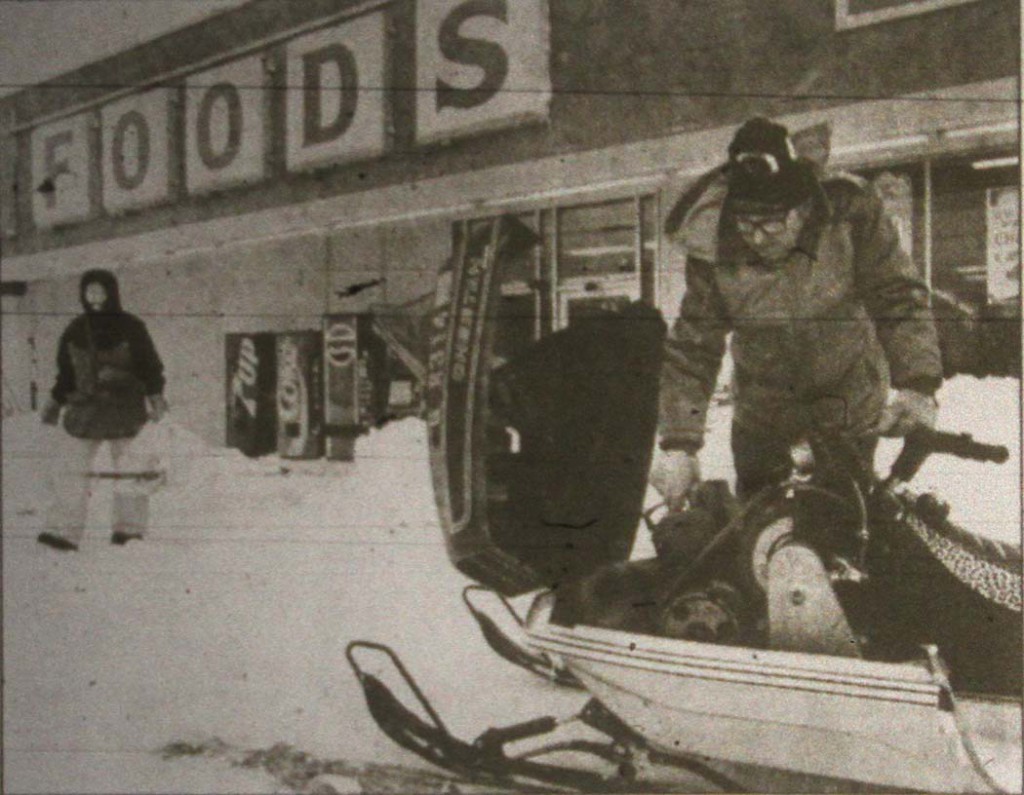 Some snowstorms are common, some are a little more severe, some are memorable, but only a select few become legendary. The Halloween snowstorm of 1991 is one such storm, it started on Halloween which helped add to its lore, it was virtually completely unexpected, and it was the single biggest snow total in the state of Minnesota’s history (Until it was eclipsed just ten years later by a fluke lake effect storm in Finland). But most importantly for our purposes here, it crippled a city and thrust the snowmobile back into prominence as the only reasonable mode of transportation and single handedly helped revive the ailing snowmobile industry. This is my personal firsthand account of perhaps the most famous snowstorm in Minnesota History.
Some snowstorms are common, some are a little more severe, some are memorable, but only a select few become legendary. The Halloween snowstorm of 1991 is one such storm, it started on Halloween which helped add to its lore, it was virtually completely unexpected, and it was the single biggest snow total in the state of Minnesota’s history (Until it was eclipsed just ten years later by a fluke lake effect storm in Finland). But most importantly for our purposes here, it crippled a city and thrust the snowmobile back into prominence as the only reasonable mode of transportation and single handedly helped revive the ailing snowmobile industry. This is my personal firsthand account of perhaps the most famous snowstorm in Minnesota History.
Although I was born in New York City, my parents moved to Duluth, Minnesota when I was just six months old. There was an Air Force base here then, and my grandfather was stationed in Duluth and absolutely loved it. My parents wanted to escape from the big city so they settled here to be close to family. I grew up riding snowmobiles at first with my parents and later with my neighborhood friends. As I reached adulthood I joined the Air Force and was stationed in Sacramento, California, not much of a snowmobiling hotspot to say the least. After my stint in the Air Force was over I returned to Duluth with my wife to attend college at the University of Wisconsin Superior. We rented an apartment in downtown Duluth so there wasn’t room in our lives to own a snowmobile, plus we were poor college kids which really put snowmobiling out of reach for us. October had been a fabulous month and when Halloween rolled around we were all still on cloud nine from the Twins winning the World Series. The forecast was pretty generic in the morning- maybe a little rain and maybe a little snow for the kids Trick-or-Treating, but nothing that would hamper their quest for candy.
As my wife and I sat in class at about one o’clock in the afternoon someone said “Hey look it’s snowing.” We looked outside to see some light flakes falling on the sidewalk but it was a little too warm for them to stick. By the time we left school the temperature had dropped and snow started accumulating on the roads and soon traffic slowed in the icy conditions. I had to work that night and as I drove to work the forecast on the radio now said that we could get 1-3 inches of snow. No big deal. By five o’clock there were vampires and princesses heading out Trick-or-Treating decked out in snow boots with snowmobile suits under their costumes and passing porches lined with Jack-o-lanterns covered in snow. I returned home from work and my friend Allen stopped by for a beer. We watched the ten o’clock news to find out that they had upgraded us to a winter storm warning and were now predicting 4-6 inches of snow, again no big deal for Duluth. At 1:00 AM Allen left my apartment and we were shocked to see a foot of snow on my porch. “This is a lot more than 4-6 inches,” he said, “I’d better get home.” When my wife and I went to bed, I fully expected to wake up the next morning, dig out my car, and go to School, but when I woke up I was shocked to see fifteen inches of snow on the ground and all classes cancelled. The snow was falling harder than it had been the night before and by the time the sun was going down there were over twenty inches of snow on the ground.
The next morning I woke up expecting to see the plows and life returning back to normal- instead, I opened the shades to find it still snowing and storm totals approaching 30 inches. Instead of a plow going by I watched a snowmobile cruise past, then another, and another. It seemed cars were now an impossibility and the only thing moving were snowmobiles. There were so many in fact that stoplights were now controlling snowmobile traffic, I had never seen anything like it. Being an avid snowmobiler conditions like this were something that I always dreamed about but now here I was trapped in my apartment with snowmobiles buzzing up and down the street torturing me. The rest of that day and night was ruled by snowmobiles with all of the parking lots of downtown bars and grocery stores full of sleds. Snowmobiles lined up at the gas stations for fuel and the entire city was their playground. It was like living in a remote Alaskan town where cars are nonexistent. We continued to watch the snow pile up until it finally ended on November 3rd with an impressive 36.9 inches on the ground and drifts in some places ten to fifteen feet high. It was then that the digging out began.
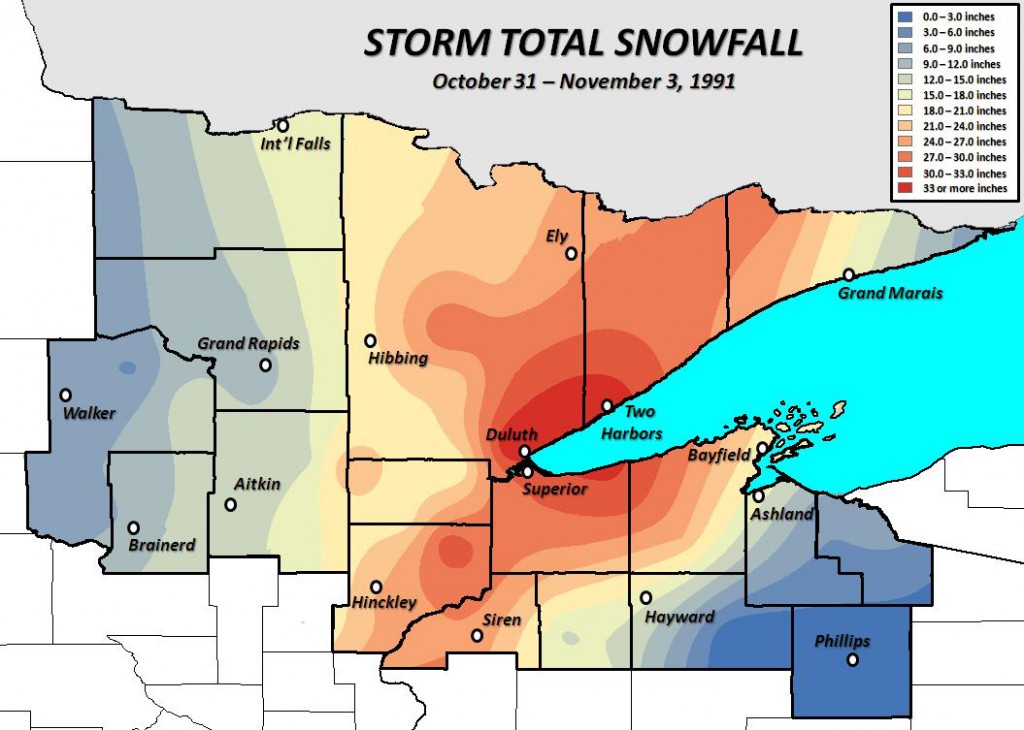
So what caused all of this and why did the weatherman fail to predict this storm? It all started with a low pressure system moving up from Texas and heading due north where it met a cold air mass dropping out of Canada. The Low gathered strength as it worked its way north and was fueled by warm moist air it was sucking up from the Gulf of Mexico. The clash of warm moist air from the south and cold air from the north produced ice in Iowa and snow in Minnesota but it when it reached Duluth that’s when things really got interesting. There was a blocking high in the East which held the low pressure system right over Lake Superior, allowing it to pick up moisture and dump it right on Duluth, like Lake effect snow on steroids. It took Duluth weeks to recover.
The interesting byproduct of this storm was it effect on the snowmobile industry because after this storm the snow just kept coming: another thirteen inches in November creating a fifty inch base. Local snowmobile dealers sold out of inventory and this started a sales explosion for the industry that would last for a decade. Fueled by a multiple seasons of good snow, sales climbed to a peak of 260,000 units in 1997, and it was all started by the Halloween Snowstorm of 1991. Since then snowmobilers anticipate the arrival of Halloween because they know that once the calendar hits October 31st a snowstorm can happen at any time. Will this winter bring another legendary early season snowstorm? We can only hope.
THE EARLY 1970′s: THE GOLDEN AGE OF SNOWMOBILES
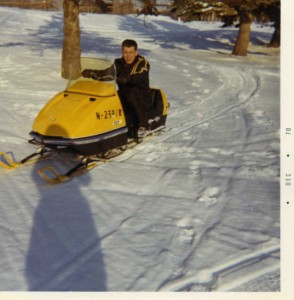 Everything has its time: the horse and buggy, dirigibles, oil lamps, the dog sled. But with time comes progress and new inventions. In 1958 Joseph Armand Bombardier created an economic small single tracked vehicle with a front mounted engine that could easily glide over snow and it changed how we view winter forever. For centuries snow had been seen as a burden, but now it was eagerly welcomed by scores of people in the north. Winter was no longer a time to be cooped up inside your home, it was a time for the whole family to get out and experience the gloriousness of the winter world. The snowmobile was an inexpensive way to access this new frontier and snowmobile sales skyrocketed. Just 13 years after the sale of the first Ski-Doo there were over 100 snowmobile manufacturers and sales climbed to a staggering 495,000 snowmobiles sold in 1971, and more importantly there were over 1.5 million snowmobiles cruising the woods and frozen lakes of the north. In the early seventies, snowmobile magazines were over 100 pages thick just to accommodate all of the ads.
Everything has its time: the horse and buggy, dirigibles, oil lamps, the dog sled. But with time comes progress and new inventions. In 1958 Joseph Armand Bombardier created an economic small single tracked vehicle with a front mounted engine that could easily glide over snow and it changed how we view winter forever. For centuries snow had been seen as a burden, but now it was eagerly welcomed by scores of people in the north. Winter was no longer a time to be cooped up inside your home, it was a time for the whole family to get out and experience the gloriousness of the winter world. The snowmobile was an inexpensive way to access this new frontier and snowmobile sales skyrocketed. Just 13 years after the sale of the first Ski-Doo there were over 100 snowmobile manufacturers and sales climbed to a staggering 495,000 snowmobiles sold in 1971, and more importantly there were over 1.5 million snowmobiles cruising the woods and frozen lakes of the north. In the early seventies, snowmobile magazines were over 100 pages thick just to accommodate all of the ads.
Full page snowmobile ads like these filled snowmobile magazines in the 1970′s
Snowmobiling was on the national news as America’s hottest new trend and all of the industry experts predicted that sales would reach over one million units per year by the late 1970’s. When sales dipped slightly to 460,000 units in 1972 no one hit the panic button, after all there were now over two million registered snowmobiles on the trails. 1973 saw EPA regulations for noise which meant testing and remanufacturing to make less noisy sleds, the result of this added research expense coupled with the first oil embargo in 1973 resulted in some of the weaker manufacturers closing up shop, as sales dropped to 450,000 the industry still seemed exceptionally strong and the disappearance of many of the fly by night manufacturers was seen as a good thing. By 1974 gas prices had increased by 300% and the stock market crash tapped into many American’s pocketbook and sales dropped again to 435,000, but with almost three million sleds now out on the snow it seemed that the industry would weather the storm, the one thing it couldn’t weather, however, was the weather.
FROM BOOM TO BUST
Every industry has its growing pains and the snowmobile industry was about to face an avalanche of market forces that would combine to decimate the marketplace. The 1973 EPA regulations were the first shot, then the oil embargo did its damage, but something else was taking place- saturation. There are only so many climates that make owning a snowmobile a worthwhile investment, meaning that there were only so many snowmobiles that could be sold. Add to that the emergence of two new recreational vehicles: The Jet Ski and the new three wheeler ATV’s. Now consumers had more choices and their recreational dollars were going elsewhere. Finally came the one thing that everyone in the snowmobile industry dreads: Poor snow conditions. A few lean snow years and then the second oil embargo in 1979 caught the snowmobile manufacturers totally off guard as sales plummeted to under 200,000 leaving many of them with excess inventory. With no way to pay their creditors due to lack of sales, snowmobile companies began collapsing and huge industry mainstays like Sno-Jet, Rupp, and Scorpion were suddenly gone. Other manufacturers that had businesses outside of the snowmobile industry like Johnson, Evinrude, Mercury, Kawasaki and John Deere got out of the snowmobile market. Even the mighty Arctic Cat went belly up but was revived by its employees banning together and resurrecting their old company. With sales dropping to a low of 103,000 in 1986 it looked like the snowmobile might be a thing of the past. There was one silver lining in all of this, however, in the mid-eighties there were still over four million snowmobiles being used around the world, a peak number that may never be seen again. The remaining manufacturers began making higher quality machines with excellent suspensions that could take advantage of what was now a well-established trail system. When the nineties began with some monster early snow years, snowmobiling experienced a giant resurgence. Although sales never reached the numbers they achieved in the early seventies, snowmobiles had made a comeback. Everything has its time and for the snowmobile that time was the early seventies. It was an exciting time to be experiencing an exciting new sport and today the popularity of vintage shows brings us back to a time when the snowmobile was the undisputed king of the recreational vehicle market.
THE 10 BEST THINGS ABOUT SNOWMOBILING
These days it seems that people make “best of” lists for just about everything, not wanting to be outdone the staff of snowmobiletrail.com got together and compiled our own list of the ten best things about snowmobiling. Here it is:
10. Reigniting your love of winter:
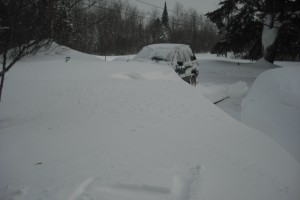 Remember when you were a kid and you would pray for snow days so you wouldn’t have to go to school and then you would spend your winter days out sliding or skiing or skating? Meanwhile your parents would be complaining about having to drive and shovel snow. As a snowmobiler you forget about all of the hassles that snowstorms bring and once again find yourself watching the weather every night hoping for a huge blizzard, the bigger the better!
Remember when you were a kid and you would pray for snow days so you wouldn’t have to go to school and then you would spend your winter days out sliding or skiing or skating? Meanwhile your parents would be complaining about having to drive and shovel snow. As a snowmobiler you forget about all of the hassles that snowstorms bring and once again find yourself watching the weather every night hoping for a huge blizzard, the bigger the better!
9. Escape: You know the feeling, you are sitting there in your cube in your office going through the same mundane humdrum of your workday, watching the clock and counting down to quitting time so you can hop on your sled and get away. Or sometimes the pressures of everyday life are crushing you and you just want to find a way to get away from it all. A snowmobile is a passport to freedom and an hour or two in the saddle can alleviate a lot of stress.
8. Adventure: Every time you climb aboard your sled you have no idea what is in store for you. I learned at a very early age that even the most routine ride can turn into an adventure of a lifetime. It is this uncertainty that keeps me coming back year after year. Trail conditions are always changing and no two rides are the same.
7. The Bonding of Man and Machine (AKA Speed and Power): Let’s face it, there’s nothing quite like being on a lake or long straightaway and cracking the throttle and feeling the sheer power of horsepower meeting snow at your fingertips. Ever since the invention of the internal combustion engine we have been obsessed with horse power. The same can be said for the overall feeling you get of your snowmobile floating through a field of deep powder or dropping into a mountain pass. The snowmobile is, after all, a machine and as human beings we have an instinct to create and use machines to feed the curious nature of our brains. The snowmobile delivers in this area in spades.
6. Seeing Things You Can’t See at any other time of year:
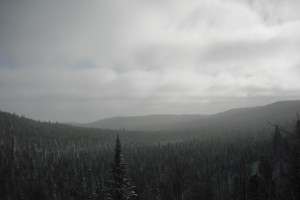 One of the greatest things about snowmobiling is being able to go places that you have never been and see things that you have never seen. Snowmobiles are capable of bringing you to places that are not accessible by any other means. There are many places around the world that can only be reached in the winter due to swampy or rocky terrain. These places are equally difficult to reach in the winter without a snowmobile. The opportunity to experience some of the places you can visit on a snowmobile cannot be equaled5. The Clothing: Snowmobile clothing has come a long way from the snowmobile suits of the sixties and seventies, now there is every imaginable style of jackets, pants, bibs, helmets, gloves, boots and anything else you want. The snowmobile clothing industry is as big as the actual snowmobile industry itself, primarily because of the awesome styles and the overall warmth and effectiveness of snowmobile clothing and layers. There has been a huge crossover here because the designers of snowmobile gear make some of the most attractive winter clothing ever made.
One of the greatest things about snowmobiling is being able to go places that you have never been and see things that you have never seen. Snowmobiles are capable of bringing you to places that are not accessible by any other means. There are many places around the world that can only be reached in the winter due to swampy or rocky terrain. These places are equally difficult to reach in the winter without a snowmobile. The opportunity to experience some of the places you can visit on a snowmobile cannot be equaled5. The Clothing: Snowmobile clothing has come a long way from the snowmobile suits of the sixties and seventies, now there is every imaginable style of jackets, pants, bibs, helmets, gloves, boots and anything else you want. The snowmobile clothing industry is as big as the actual snowmobile industry itself, primarily because of the awesome styles and the overall warmth and effectiveness of snowmobile clothing and layers. There has been a huge crossover here because the designers of snowmobile gear make some of the most attractive winter clothing ever made.
4. Being Part of The Snowmobile Community:
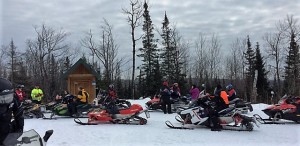 People want to belong. The snowmobile fraternity is a great group to belong to. There is a sense of comradery when you pull into your favorite trailside bar for a burger or when you stop to take a break at a shelter. There’s a lot to be said for sitting by a cozy fire with other snowmobilers after a long day on the trail recapping the days adventures. There’s also a lot to be said when you have buried your sled and other riders stop to help you dig out! The snowmobile community is truly a brotherhood of people that share a passion, and in a world that can’t seem to agree on anything these days, it feels good to be around people that love something as much as you do.
People want to belong. The snowmobile fraternity is a great group to belong to. There is a sense of comradery when you pull into your favorite trailside bar for a burger or when you stop to take a break at a shelter. There’s a lot to be said for sitting by a cozy fire with other snowmobilers after a long day on the trail recapping the days adventures. There’s also a lot to be said when you have buried your sled and other riders stop to help you dig out! The snowmobile community is truly a brotherhood of people that share a passion, and in a world that can’t seem to agree on anything these days, it feels good to be around people that love something as much as you do.
3. Connecting With The Wilderness: Human beings were not meant to be confined in an office or caught in traffic or sitting on a couch in the suburbs, we were meant to be free and to be interacting with the natural world around us. Snowmobiling helps you escape the concrete jungle and get back into the wilderness where you belong. This is the reason that every weekend there is an endless caravan of trucks and trailers fleeing the city and heading to Northern Minnesota, Northern Wisconsin, the U.P., the mountains, or wherever that great snowmobiling paradise is in your state. Snowmobiling can get you into wild areas where you can see animals that you won’t see in your everyday life. Here in Northeast Minnesota we’ve run across moose, deer, owls, bald eagles and even a few wolves and we can tell you there are very few things that can compare to seeing these animals in their natural habitat.
2. Snowstorms:
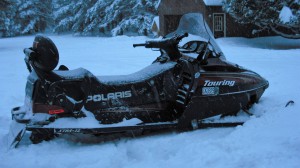 You are watching the weather forecast on the ten o’clock news and the weatherman says that a big storm is coming, you wake up in the morning like a kid on Christmas morning and you look out the window to see snow falling at a furious pace, school has been cancelled, work is closed, roads are closed, everyone is snowed in. You grab your gear throw on your helmet and hit the powder and you spend the rest of the day riding. This is every snowmobilers’ dream scenario and when it happens there is nothing that can really compare to it. For every bad snow year and every time that conditions aren’t ideal they are all erased by being able to ride in one good storm. We’ve heard many snowmobilers say that it’s worth owning a snowmobile just to be able to ride when there is a big snowstorm and we agree.
You are watching the weather forecast on the ten o’clock news and the weatherman says that a big storm is coming, you wake up in the morning like a kid on Christmas morning and you look out the window to see snow falling at a furious pace, school has been cancelled, work is closed, roads are closed, everyone is snowed in. You grab your gear throw on your helmet and hit the powder and you spend the rest of the day riding. This is every snowmobilers’ dream scenario and when it happens there is nothing that can really compare to it. For every bad snow year and every time that conditions aren’t ideal they are all erased by being able to ride in one good storm. We’ve heard many snowmobilers say that it’s worth owning a snowmobile just to be able to ride when there is a big snowstorm and we agree.
1. Family:
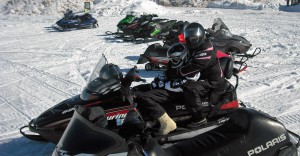 95% of all snowmobiliers cite “Spending Time with Family” as one of their favorite things about snowmobiling. Snowmobiling is the ultimate family sport and is enjoyed by mothers, fathers and children alike. Many snowmobilers that started out riding with their parents as youths continue to ride with them throughout their adult years and it’s common to see three generations of snowmobilers out on the trail together. In this world where every person in the family seems to be constantly on the go doing their own thing, to have something like snowmobiling to bring a family together makes this hands down the number one thing on our list.
95% of all snowmobiliers cite “Spending Time with Family” as one of their favorite things about snowmobiling. Snowmobiling is the ultimate family sport and is enjoyed by mothers, fathers and children alike. Many snowmobilers that started out riding with their parents as youths continue to ride with them throughout their adult years and it’s common to see three generations of snowmobilers out on the trail together. In this world where every person in the family seems to be constantly on the go doing their own thing, to have something like snowmobiling to bring a family together makes this hands down the number one thing on our list.
THE SLOW DISAPPEARANCE OF THE 90′s ERA SNOWMOBILE
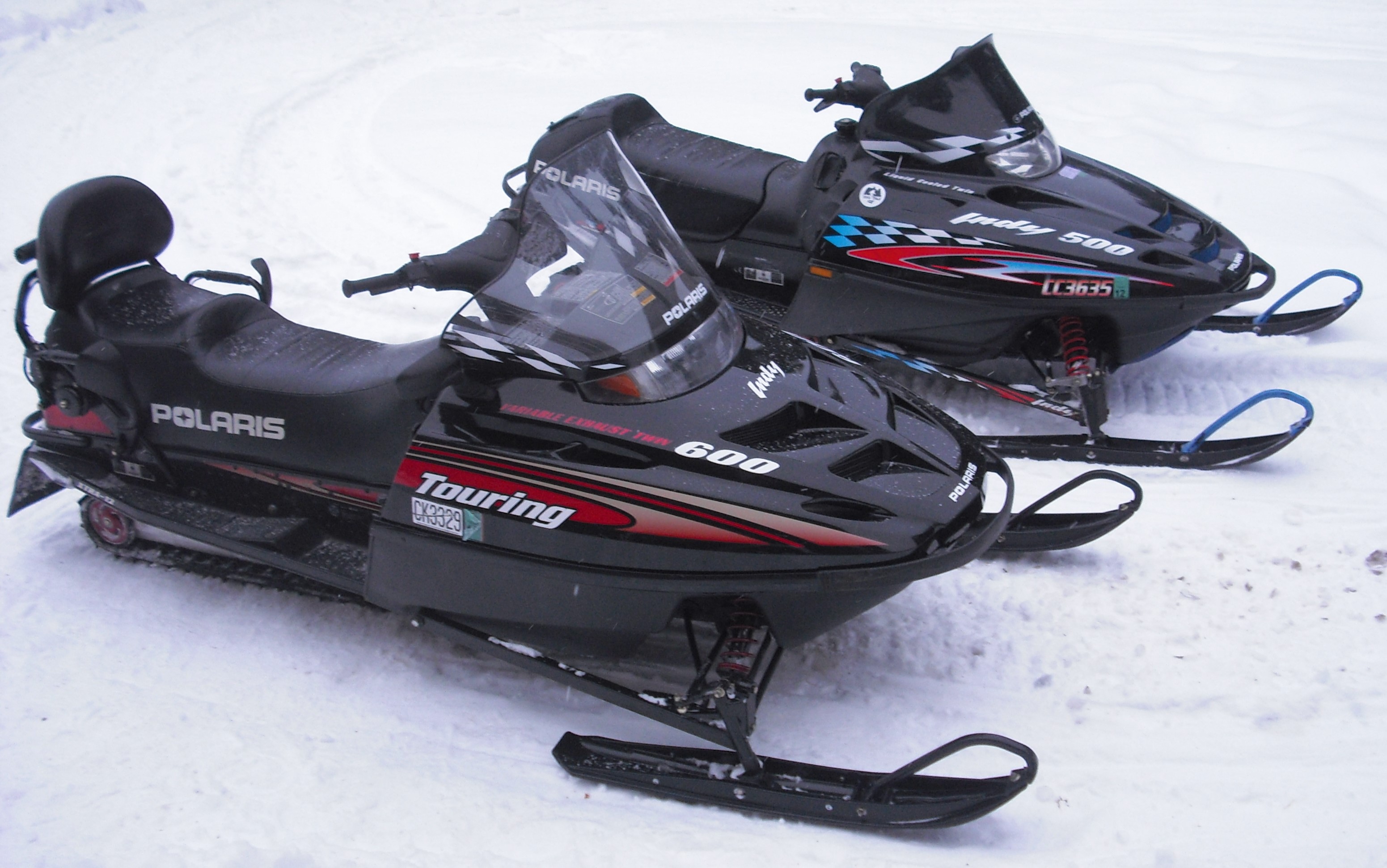
Late last winter I was on a ride with the other snowmobiletrail.com staff members and we stopped at one of our favorite watering holes to take a little break. As I was sitting outside looking at all of the snowmobiles parked in the lot, it struck me how many older style sleds there were (by older style I mean the pre rider forward design). I began wondering why with all of this fantastic new technology available that there were still so many people punishing their bodies on the trail riding old iron.
I saw this same trend back in the eighties as the overwhelming majority of snowmobiles on the trail in that decade were still sleds built in the 1970’s. This is relevant because some of the same forces that were at work in the 80’s are repeating themselves today.
The 80’s were a horrible decade for the snowmobile in general, the trail systems were not well established, the sleds being built weren’t that far off from what had been developed in the seventies, the economy in the northern states wasn’t that good and most important of all snowfall was scarce. It would take a landmark technological advancement to change the face of snowmobiling and launch it into the future, and that technological advance came in the form of Polaris’ Independent Front Suspension.
When Polaris’ IFS sleds hit the market, it quickly became clear to the remaining manufacturers that to survive they had to develop some sort of IFS sled themselves or face certain death. The IFS was so superior in ride quality that it finally put those hordes of 1970’s era sleds and even a huge number of 1980’s sleds out to pasture. Led by Polaris, the snowmobile industry saw a rebirth in the nineties as sales climbed into numbers not seen in over a decade, and the undisputed champion of the era was the Polaris Indy 500. As we passed into the new millennium it seemed that the snowmobile had found its perfect evolution of design and that the real work left to be done was in suspensions and in creating purpose built snowmobiles for the mountains, trail performance, crossovers and touring. But in 2003 Ski-Doo once again shocked the snowmobile world with its introduction of the rider forward designed REV chassis. Once the public experienced the superior ride quality of the rider forward design, the traditional snowmobile designs of the past met a rapid demise. Polaris, Yamaha and Arctic Cat suddenly found themselves scrambling to catch up as Ski-doo captured huge portions of market share.
Now that all of the manufacturers have adopted the rider forward design and the snowmobile of today provides such a superior riding experience to the sleds of the past, then why haven’t those 1990’s era sleds disappeared as readily as snowmobiles from the 70’s and 80’s did when the 1990’s IFS sleds arrived? By the mid-nineties one would be hard pressed to find any remaining 70’s or 80’s sleds left on the trail, but yet here we are, fourteen years after the advent of the REV chassis and still nearly 60% of the snowmobiles on the trails today are still of the old 90’s type design. The reasons for this slow disappearance of 90’s style sleds can be attributed to a number of factors…
1. PRICE: The snowmobiles that are sold today are the best snowmobiles that have ever been manufactured. Their reliability, durability and ride quality are unmatched by anything that has come before but all of these technological advancements come at a price and unfortunately those prices get passed on to consumers. The result of this technology boom are high price tags and in an economy that is in various stages of unstableness, price is a huge limiting factor in new sled purchases. The price of a brand new snowmobile puts many of them out reach for the average consumer so if you want to buy a rider forward sled without buying new your only other option is a very small used rider forward sled market. Not a lot of rider forward sleds come on the used market and when they do they are bought up right away usually at a premium price. Ski-Doo was the first to notice that their early REV chassis sleds were commanding big dollars in the used marketplace which made them introduce the low end TNT with a carbed 600 engine in the REV chassis for a very reasonable price. This gave perspective buyers a better option: instead of paying premium dollars for a used REV sled with loads of miles on it, they could now purchase a new snowmobile with the same technology for less. Arctic Cat picked up on this trend with the introduction of their Sno Pro 500. The huge success of the TNT and Sno Pro helped nudge Polaris into bringing back the legendary Indy nameplate with a 600 fuel injected sled hoping their loyal old Indy riders would take the leap to new technology. Still even with these less expensive new sled alternatives you can still buy a quality 90’s sled for $1,000 or less, sure the ride isn’t as good but it is still respectable and for dads with snowmobiling kids that want their own sled, those reliable 90’s machines are a great way to go to build your family’s snowmobile fleet for not a whole lot of cash.
2. THE PROLIFERATION OF 1990’s SLEDS: In the nineties snowmobile sales saw a huge resurgence. From 1990 to the advent of the rider forward sled in 2003, 2.7 Million snowmobiles were sold. Compare that to the 1.9 million that have been sold since and it is obvious why there are still so many 90’s era sleds still on the trail. This same bubble was seen in the 1980’s. From 1970 through 1979 a staggering 3.4 Million snowmobiles were sold- compare that to 1980 through 1989’s numbers (snowmobiling’s worst decade) of only 1.3 Million and you can see why there was so much 70’s iron on the trail through the 80’s.
3. APPEARANCE: Let’s face it, there were a lot of people turned off by the funky looking rider forward sleds and they are a giant pain in the butt to work on compared to all that room you had under the hood in the 90’s.
4. DURABILITY: Unlike snowmobiles of the 60’s and 70’s which spent as much time getting wrenched on in the garage as they did on the trail, the 1990’s sleds set new standards in reliability and quality and they flat out last. So why buy a new snowmobile when your old one gets the job done with not much more than routine maintenance? Personally it took me blowing up my old Indy and needing major suspension and engine work on a well-worn chassis that finally made me say goodbye to my old sled and join the 21st century. I soon found out, however, that the market for junked Indy 500’s is huge. I literally sold my dead Indy within five minutes of it hitting Craig’s List. This is another factor keeping those 90’s era sleds on the trail- parts for them are plentiful and makes rebuilding engines and suspensions a cost effective alternative.
5. SNOW: Nothing dictates snowmobile sales more than snow. One of the biggest factors that drove the 90’s boom were some really big snow years. For the last few seasons snow has been hard to find. Considering that Minnesota, Michigan and Wisconsin are responsible for the overwhelming majority of snowmobile sales in the United States, a bad snow year in those three states can put a real damper on new sled sales and three or four bad snow years in a row can be catastrophic. Lack of snow keeps the existing snowmobiles sitting in people’s garages and as a result they don’t wear out, thus no need to buy new. Throw in a few winters of heavy snow and many of those 90’s sleds, like my Indy, will meet their demise. As they say, father time is undefeated. The more snow there is the more of a need there is for snowmobiles. When snow is abundant, the inventory of new sleds can dwindle quickly.
Inevitably the 90’s body style snowmobiles will slowly disappear as more and more people experience the superior ride quality of the new rider forward designs and as the used market continues to offer some of the older rider forward snowmobiles at prices closer to their 90’s era counterparts. One day the 90’s style sleds will be relegated to vintage shows where grandpa will be telling tales of trailing arms and sore backs, much like we speak fondly of bogie wheels and leaf springs of the 70’s. But with the massive amounts of quality snowmobiles sold in the nineties, the availability of parts and that eras sleds level of overall toughness, I don’t think that day will be here any time soon.
FIRST DAY OF FALL GETS US THINKING ABOUT SNOW
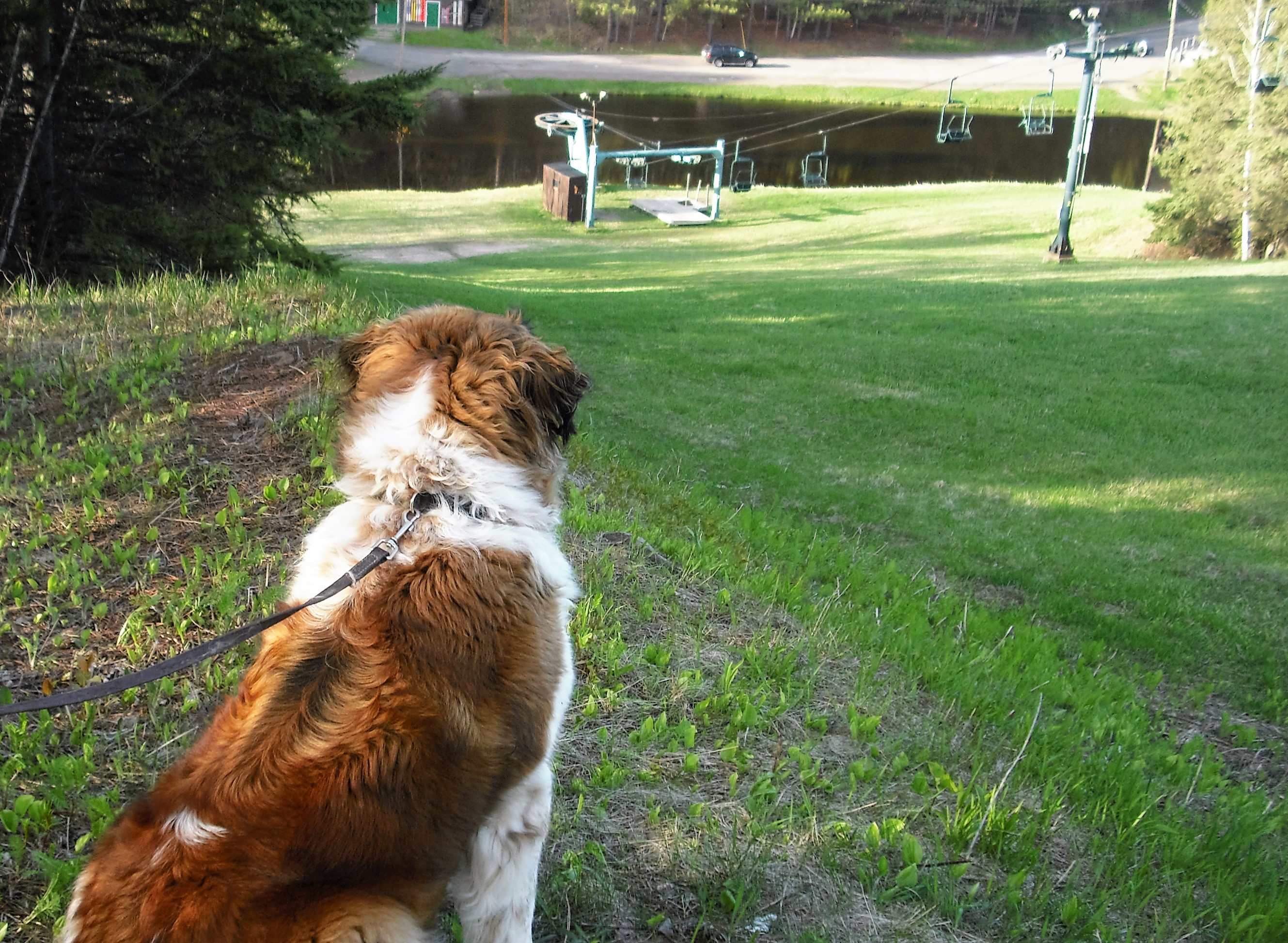
Snowmobilers aren’t the only ones waiting for snow. This St. Bernard is patiently waiting at its post on the ski hill for snowflakes to start falling.
September 22nd, the first day of fall. There was a definite crispness in the air today and the leaves are starting to change colors. This is the time the antsiness starts setting in for us here at snwmobiletrail.com. In just over a week we break into blog season where we start throwing stuff at you to get you pumped up for winter. We’ve got a ton of great articles for you that you wont want to miss. We would also like to welcome our snowmobiling friends in New York and North Dakota who have been added to our growing network of snowmobiletrail.com followers. We are hoping for a big snow year this year so cross your fingers and check in often for updates.
MANY MINNESOTA SNOWMOBILE CLUBS GET TO WORK EARLY
With all of the major blowdowns from the powerful storms that rolled through the state this summer, snowmobile cubs are already out on the trails clearing brush and downed trees. The area around Duluth was especially hard hit with two major storms that took out thousands of trees and downed power lines for tens of thousands of residents. “We’ve got about a month and a half of cutting to do to get the trails ready,” said one club spokesman, “and that is if we get full crews to work every weekend.” Part of the problem is that many snowmobile trails go through swampy areas that are difficult to access if there is still a lot of water around. “We’re hoping to get all of the high ground stuff done before our normal trail prep starts in November, hopefully we get early cold weather so we can get out and have all of the trails open by December 1st.” The other issue facing the clubs is manpower. Snowmobile clubs are a 100% volunteer effort and they need manpower to get the work done. If you enjoy any local trails and you are not part of a club we suggest joining one right away- they could all use your help in getting your favorite trails ready for the snow.
WHY GOD CREATED SUMMER
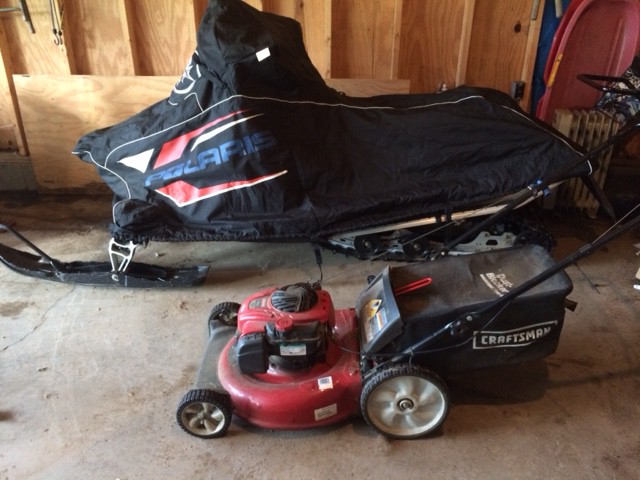 My family have been Vikings season ticket holders since 1998. When I first got my season tickets I was like a lot of Vikings fans who were in their late 20′s and early 30′s, I loved the Vikings and I believed in my heart that they would win every game. My father-in-law on the other hand was the most cynical and apathetic Vikings fan on the face of the earth. Don’t get me wrong, he loved the Vikings and luckily had instilled that love of football in his daughters. My wife is an even bigger football fan than I am. Vikings games to her family are like a religion (you know you hit the jackpot when your wife comes to you and says “don’t make any plans for Sunday because we are getting a bunch of beer and watching football all day”) But I hated watching games with her dad because all he talked about was how they were going to find a way to lose. I asked him one day why he was so cynical and why he even bothered to watch the games if he was going to be so negative all of the time. He told me “when I was young like you I believed in the Vikings, I believed they would win and I would get mad and throw things at the TV just like you do, but after watching them lose four super bowls I realized they are never going to win anything. One day you will be my age and you will realize that no matter how good of a season they are having it will ultimately end in failure. But year after year you will keep coming back. The Vikings are like your kids, no matter how bad they screw up you still love them. I promise you, one day you will be just like me- its just a matter of time.” I told him that he was crazy and that I would never be like him.
My family have been Vikings season ticket holders since 1998. When I first got my season tickets I was like a lot of Vikings fans who were in their late 20′s and early 30′s, I loved the Vikings and I believed in my heart that they would win every game. My father-in-law on the other hand was the most cynical and apathetic Vikings fan on the face of the earth. Don’t get me wrong, he loved the Vikings and luckily had instilled that love of football in his daughters. My wife is an even bigger football fan than I am. Vikings games to her family are like a religion (you know you hit the jackpot when your wife comes to you and says “don’t make any plans for Sunday because we are getting a bunch of beer and watching football all day”) But I hated watching games with her dad because all he talked about was how they were going to find a way to lose. I asked him one day why he was so cynical and why he even bothered to watch the games if he was going to be so negative all of the time. He told me “when I was young like you I believed in the Vikings, I believed they would win and I would get mad and throw things at the TV just like you do, but after watching them lose four super bowls I realized they are never going to win anything. One day you will be my age and you will realize that no matter how good of a season they are having it will ultimately end in failure. But year after year you will keep coming back. The Vikings are like your kids, no matter how bad they screw up you still love them. I promise you, one day you will be just like me- its just a matter of time.” I told him that he was crazy and that I would never be like him.
So there I was, 17 years of disappointment later, sitting on my couch watching the Vikings playing the Seahawks this past January and watching Blair Walsh lining up for an easy chip shot field goal, telling my wife “I bet he misses this and we lose.” Five seconds later I was turning off the TV wondering how I had managed to turn into my father-in-law and wondering why I even bother putting myself through this yearly abuse. “I’m sick of this,” I told my wife, “we do this same thing year after year. We waste our time watching this team knowing full well they are never going to win the Super Bowl. I’m done, I’m never watching the Vikings again.”
Now here we are in the preseason and once again my wife and I can’t wait for football season to start even though we know it will end like it always does, with the Vikings failing to deliver the Super Bowl. It is then that it hit me- football has an off season just so you can have time to forget about your disappointment and get excited all over again for the next season. This is the same reason that God gave us summer. Sure I’ve thought about how great it would have been to live in an ice age where you could ride all year round, but then I realized that if we could ride every day, we might actually get bored with it. It would be like opening Christmas presents every day all year long, it loses its specialness. Summer comes for us to enjoy golf, fishing, the beach, burgers on the grill and a cooler full of ice cold beer. Then there are the days that you have to mow the lawn and when you are done you put that lawnmower away right next to the snowblower and your snowmobile as they wait there like silent sentries for their moment to be called into service. One day soon you will wake up and there will be that cold tinge in the air and the smell of leaves getting ready to fall off their trees and you’ll pull the cover off of your sled and start getting it prepped for winter way too early. October will come and you will look at the calendar and see the days rolling by getting you closer and closer to Halloween and, if you live in Northeast Minnesota, you know that Halloween is the magic date because once November hits you can start watching the weather every night for that early season snow, knowing that this might be the year when that Early November snow falls and stays on the ground until April (see 1991). That is what summer is for, to rekindle that childhood excitement that you felt every fall and to get you to those nights in November and December when you flick on the floodlights and hope to see the air filled with white flakes from Heaven. God new what he was doing. Now if He could just do something about the Vikings…
THE WINTER OF 2015/16 MEETS A QUICK DEATH
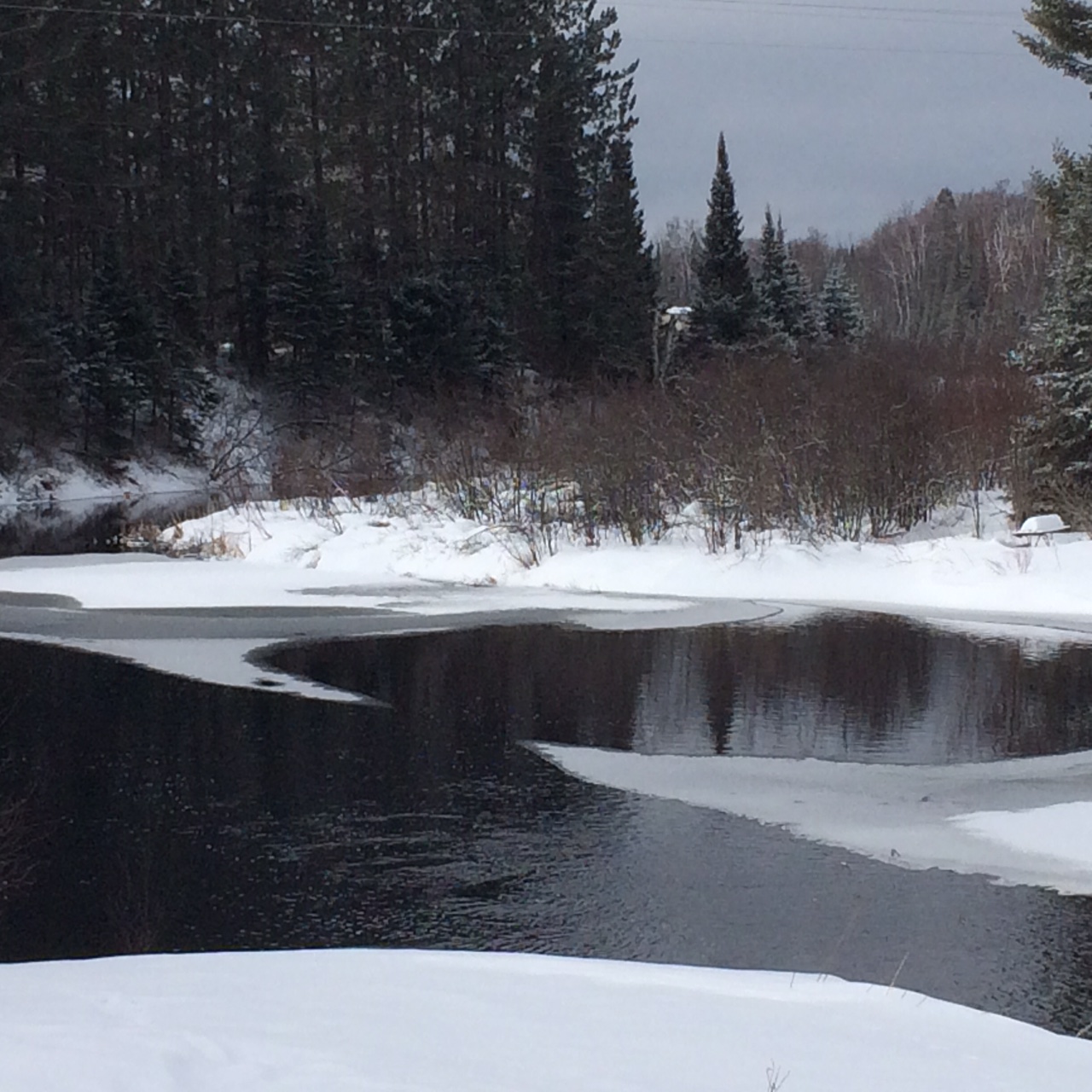 As Snowmobilers we have all experienced it: insensitive coworkers in your office that complain the entire winter about snow and cold and rejoice when the temperature climbs above freezing and starts melting away the snowmobilers’ most precious commodity. I always ask myself what is wrong with these people and why do they live in Minnesota if they hate snow so much? It’s like living in Death Valley and complaining about how hot it is.
As Snowmobilers we have all experienced it: insensitive coworkers in your office that complain the entire winter about snow and cold and rejoice when the temperature climbs above freezing and starts melting away the snowmobilers’ most precious commodity. I always ask myself what is wrong with these people and why do they live in Minnesota if they hate snow so much? It’s like living in Death Valley and complaining about how hot it is.
We are a lucky bunch in Minnesota because like Wisconsin and Michigan the big population centers in the south of the state can trailer up their sleds and head north to experience snowmobiling at its finest. Although Northeast Minnesota doesn’t get the really heavy lake effect snow like Wisconsin, Michigan and New York get, we still get some snow that drifts in off of Lake Superior and we also get the advantage of having some higher elevations that tend to produce more snow. The other advantage we have over the other states in the snow belt is that we are farther north and as a result winter comes early and stays late, which gives us rideable snow before Michigan and Wisconsin and it hangs around longer also. I keep debating if it would be better to be in the UP where you are assured a ton of snow every year but a shorter season or if is better to get not as much snow but a season that usually starts earlier and lasts longer. I’m sure the people in the UP look at us when they are getting rain and we are getting snow and think how lucky we are as much as we look at them getting snow every day in January and thinking how lucky they are.
Our scenario “Up North” is the same year after year: hordes of trailers coming from the Twin Cities early and late in the season to take advantage of our snow. This was again the case this past weekend as everyone flocked to the trails to get in a days’ worth of riding and still catch the state High School Hockey Championship games on TV (we are in the State of Hockey after all and if there is one thing that may trump snowmobiling its hockey- or the Vikings being in the Super Bowl, but we’ll never have to worry about that). The staff at snowmobiletrail.com saw the writing on the wall and we hammered out 140 miles on the day ourselves, once again meeting dozens of fellow snowmobilers out enjoying one last shot of Heaven. Unfortunately the winter season came to an abrupt end on Sunday with fifty degree temps melting away what was left of the trails. In the extreme north there may be some snow left but the scheduled rain for midweek will probably put an end to things up there also.
The 2015/16 winter, although better than 2014/15 was still a bit disappointing. We started the year with the extreme Northern trails being hit with a viscous storm of heavy wet snow that toppled trees and brush across miles and miles of trails. Local snowmobile clubs worked for weeks on end to get things cleaned up. Across the state the unusually warm December and January temperatures kept any base from building on the trails and kept all of the swamps, streams, and lakes from freezing, leaving nearly all of the GIA trails closed even though there was adequate snow in some areas. It wasn’t until January 10th that the temperatures dropped below zero and started freezing everything up, allowing the groomers to get out and finally pack the trails. By the weekend of the sixteenth we had received a couple inches of snow and the groomers opened everything up. The season was short lived as we never got any big snowfalls for the second year in a row and although the trails opened, they never made it past a “good” condition rating because we never developed that twelve inch base that is the magic number for a groomer to really move snow around and build a perfect trail. By February 20th the rains came and really worked to destroy what little base there was, we followed that up with a weekend of fifty degree temps to nearly obliterate everything. We were lucky enough to get a few more inches of snow and cold temps for the groomers to give us one last day of fun but now winter has flatlined and it’s not coming back.
Despite the weather we still managed to throw on some decent mileage this year and got to try out some cold weather set ups that make riding in extreme conditions almost effortless. I am confident going into 2016/17 that if the temps drop below zero I’ll be able to rack up long days on the trail without any negative effects. We are also upgrading some of the software on the website to improve the trail maps and capture a wider audience of snowmobilers. Additionally we have a few new features coming out in the blog next year with trail reviews, destination suggestions, vintage snowmobile features, industry updates, entertaining stories from the trails and our newest feature “Today on the Trail” where the staff of snowmobiletrail.com shares photos of the snowmobilers we meet on the trail. Look for us out on the trail next winter! In the meantime like us on Facebook so you can get updates on trail conditions and network with fellow snowmobilers, the more people we have on Facebook the more updates we can get from around the state and places outside of Minnesota that have good snow conditions when ours are in the tank. Make sure to check the blog starting in October where we give you a slew of articles to get you pumped up for winter. Thanks to all of the people that use the website and we will see you next season!
